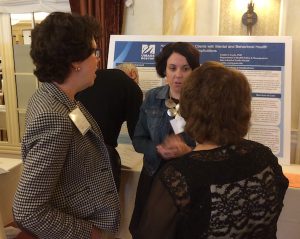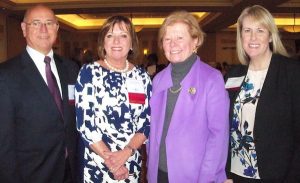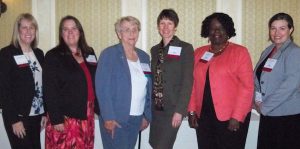Oct 14, 2016
Building Healthy Communities Is Focus of Massachusetts Healthcare Workforce Summit
“Building healthy communities as a team sport” was the overarching message of the 3rd Annual Massachusetts Healthcare Workforce Summit. Nurses from all practice settings are partnering with “teammates” in mental and behavior health, social services, and business to improve health and healthcare across the Commonwealth.

In addition to formal presentations, the 3rd Annual Healthcare Workforce Summit provided informal opportunities for connections and education.
More than 140 nurses and leaders from across the healthcare spectrum attended the September event, which was hosted by the Massachusetts Action Coalition (MAAC), a partnership of the MA Dept. of Higher Education and the Organization of Nurse Leaders of MA & RI.
“Everyone has a stake in better healthcare and healthier communities,” said MAAC Project Director Patricia Crombie, MSN, RN. “As we mark the Coalition’s fifth anniversary, we’re delighted to be expanding our membership to include public health nurses, school nurses, community health centers, and more employers and businesses and to be strengthening partnerships working toward improved health for every resident and community in the state.” Highlights of the MAAC’s accomplishments and goals are available in Crombie’s presentation slides here.
Retail is Health Care’s New Front Door
While attendees were not surprised when keynote speaker Joanne Disch, PhD, RN, FAAN, Professor ad Honorem at the University of Minnesota School of Nursing, said that “the delivery of health care is changing,” there were plenty of raised eyebrows when she showed a photo of a “Flu Shots Available” sign outside a gas station.

David Cedrone, Associate Commissioner for Economic and Workforce Development, MA Dept. of Higher Education; Patricia Crombie, Project Director for MA Action Coalition and APIN Grant; Joanne Disch, Professor ad Honorem, University of Minnesota School of Nursing; Amanda Stefancyk Oberlies, CEO, Organization of Nurse Leaders, MA, RI, NH, CT.
The location of care delivery is changing, with technology and practice innovations expanding options, said Disch. Who provides the care is changing also, with social workers, nutritionists, and mental health therapists (among others) joining nurses and physicians as providers.
Counterintuitive Strategies for Building Culture of Health
Disch urged participants to use new, sometimes counterintuitive, strategies to find solutions to improve health and healthcare:
Embrace the paradoxes of your situation: Rather than rail against the seeming impossibility of mandates to “do more with less” or “improve quality and reduce costs,” move away from an either-or, us-vs-them framework. Invite solutions by asking, “what do we agree on?” or “what goals do we share?”
Seek ambiguity: Understand that there is rarely a single correct solution to any given problem. Learn to be comfortable with different methods of care delivery and problem solving. “We’ve always done it that way” is not conducive to new solutions.
Practice creativity and be open to new solutions: Disch recounted an example of homeless patient with heart disease who, upon discharge, was asked to track his level of fluid retention. While daily weight tracking may be the preferred monitoring method, it was not feasible for this individual. “If your shoes start to feel tight, come back and see us” was the best solution for this individual to get the care he needed.
Disch’s presentation slides are available for download here.
Elements of Success for Academic Progression Efforts
The second keynote highlighted one of the MAAC’s key priorities, the academic progression of nurses. Supported by grants from the Robert Wood Johnson Foundation (RWJF), action coalitions in nine states, including Massachusetts, have implemented programs to create a more highly educated, diverse nursing workforce by making it easier for current and future nurses to earn a bachelor’s degree or higher.
Tina Gerardi, MS, RN, CAE, Deputy Director of RWJF’s Academic Progression in Nursing (APIN) initiative, shared the six essential elements for successful initiatives that her office has identified after four years of site visits, interviews, and analysis of APIN grant recipients.
- strong relationships among schools of nursing, practice and clinical settings, and healthcare employers;
- strong leadership, that is, at least one person who took responsibility to keep projects on track and moving forward;
- support infrastructure of a dedicated staff member who handled administrative logistics and follow-up, including regular reporting;
- institutionalization strategies that identified and prioritized programs that could be sustained after APIN grant funding had ended;
- formal and informal partnerships across many settings, such as community colleges and universities, education and practice settings, LPN, RN, and BSN academic programs;
- clearly defined competencies, such as the Nurse of the Future Nursing Core Competencies developed in Massachusetts, so that the transfer of credits and academic progression could be facilitated.
Gerardi’s presentation slides, “Outcomes from the APIN Grant: Academic Progression Strategies to Assist Current and Future RNs Achieve the BSN,” are available here.

Panelists shared experiences with innovative initiatives to improve the health of their communities. (Left to right) Facilitator Amanda Stefancyk Oberlies, Organization of Nurse Leaders, MA, RI, NH, CT; Dr. Wendy Brooks Barr, Greater Lawrence Family Health Center; Charlotte Stepanian, MA Association of Public Health Nurses; Julia Dyck, Health Care Workforce Center; Sharon Callender, Mattapan Community Health Center; Kathleen O’Brien, Everett Community Health Partnership.
A panel of healthcare organizations shared their experiences with innovative initiatives to improve the health of their communities. Read more about these community-based efforts in “Examples of Innovations to Build Healthy Communities.”
In lively, small group discussions, Summit participants shared ideas and strategies for Building a Culture of Health in their own communities and workplaces. They identified promising projects and what was needed to engage more partners – from both in and outside healthcare — and expand awareness of these efforts.
